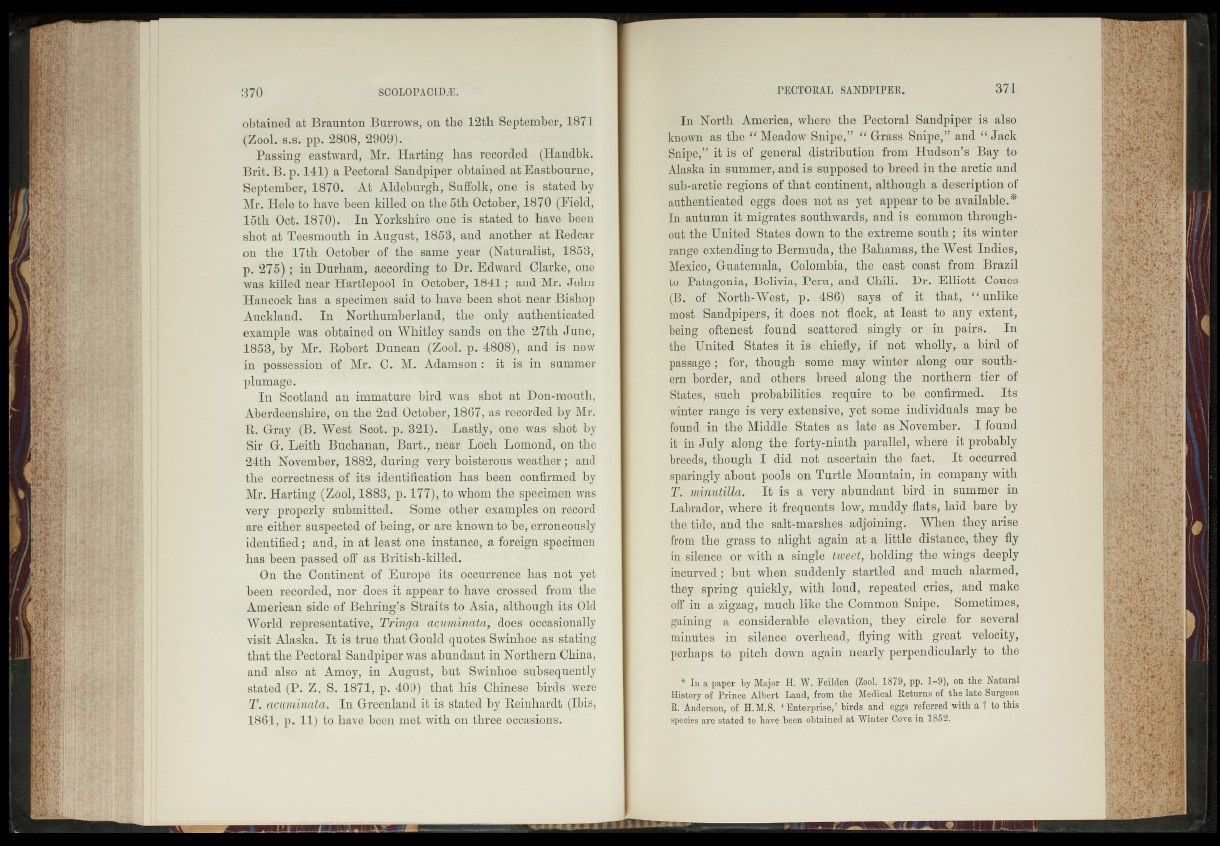
obtained at Braunton Burrows, on thé 12th September, 1871
(Zool. s.s. pp. 2808, 2909).
Passing eastward, Mr. Harting lias recorded (Handbk.
Brit. B. p. 141) a Pectoral Sandpiper obtained at Ekstboürne,
September, 1870. At Aldeburgh,. Suffolk, one is stated by
Mr. Hele to have been killed on the fytb October, 1870 (Field,
15th Oct. 1870). In Yorkshire one is statedth-have been
shot at Teesmouth in August, 1853, and another at Kedear
on the 17th October of, the same year »(Naturalist/1853-,
p. 275) ; in Durham, according to Dr. Edward Clarke,* one
was killed near Hartlepool in October, 1844 ; and Mr. John
Hancock has a specimen said tb have been shot near Blfihbp
Auckland. In Northumberland, »the only authenticated
example was obtained on Whitley sands onrthe 27th June,
1853, by Mr.: Robert Dunean (Zool.'p.' 4808)', and now
in possession off MB* C. M. - Adamson : at i&.in summer
plumage.
In Scotland an immature bird was ^shot ;at> Don-.mouth,
Aberdeenshire, on the-2nd Gctobeic, 1867y-as recorded^ Mr.
R. Gray (B. West Scot. p.»-324).; Easily, oh©. Was shot by
Sir G. Leith Buchanan, Bart., near Loch Lomond, on the
24th November, 1882, during very boisterous-weather ytmd
the correctness of its identification has been oonfiimed’ ly
Mr. Harting (Zool, 1883, p. 177);<±o whom thevspe crmearwa's
very properly submitted. Some other examples'én record
are either suspected of-being,-or are knownrt©rbe,; erroheeh|ly
identified; and, in at least one instance, a foreign specimen
has been passed off as British-MMfecl." * ’
On the Continent of Europe its occurrence has not :yëfc
been recorded, nor doeMfaappeapto have crossed , from the
American side.of Behring’s-Straits «to Asia; although it s'3 Old
World representative,.* Tnn§a ?cb$iimkn'®ta}-<Mem occasionally
visit Alaska. It fs^true that Gould -quotes SwinMe *as stating
that the Pectoral Sandpiper was abundant in NorthernsChiaia,
and also at,’-Amoy, in AuguflS/bat Swinhoe subsequently
stated (-W %. -S. 1871, pt'4M| that his ^aihe'se hards* were
. In .Greenland is, statoflJ^S, Bei©hardt - (Jpig,
f S ||, p. 11) to have been-mét with on three occasions.
In North America, where the Pectoral Sandpiper is • also
known as the “ Meadow Snipe,” Grass Snipe,” and “ Jack
Snipe,” it is of general distribution from Hudson’s Bay to
Alaska in summer, and is supposed to breed in the arctic and
sub-arctic regions of that continent, although .’a. description of
authenticated egg8 does nbt as yet/ appear to be available,*
In autumn it migrates southwards, and is common throughout
the United States down to the extreme souths its winter
range--extending to Bermuda, the Bahamas, the West;. Indies,
Mexico, Guatemala, Colombia, the east coast from Brazil
to'Patagonia, Bolivia, Peru, and Chili. Dr.iJSllibttr Cöués
(B. of North-Westh-p. 400) Bays of it that, “ unlike,
most Sandpipers, i-t-doeg-not flock, at least" to any extent,
being/éftênest found scattered singly or in-pairs.. In
the - United States it i& chiefly^ if not wholly, a bird .of
p a ssag e fo r; though some may winter along our south*
ernnborder, and others . brééd- along the -northern SÜÜp of
States^<• such probabilities^ require to’ he - confirmed. It#
winter range -is very extensive, <yet-,some individuals may be
found in the Middle States as late as November^ -firfbund
it in July along the: fertphinth -parallel., where:it probably;
breedgyuthough I- did: not j ascertain the facte-.:; It occurred
sparingly about pools on Turtle Mountain, in company with-
T^mnutilla, . It is a very .abundant bird rip summer in
Labrador, where it.frequents.,Jo^,4ïnu.ddy flat&^laid hare by
thf&tide, and the saltrmarshes, adjoining; „ When they wise
from the. grass to alight again at a^little distance, they* fly
in -sttence or with a single tW-pM, holding the. wings. de*eply
incurved; hut when ..suddenly and much alarmed;
they spring quickly,- with :lóu.d,; repeated pries,; and make
off in arz-igzag, much like 4he* Common, Snipe.. Sometimes/
gaining a considerable elevation, they, eirclor for several
minutes in sflêhée overhead, flying with great velocity,»
perhaps .to pitch':down again nearly perpendicularly to' the
* In a paper .by Major H. W. FpiMen ^^^D.1870, pp. 1-9); on the Natural
History of Prince Albert Land, from the M.edip&i Returns .of, the late Surgeon
j . j&tiderêon/of H.£M.S. i EittêipngeJ’ -birds Wd* eggs' referred' with a 1 to this
iipgcies are stated to have been obtained*at Winter Oósp in 1852."^.